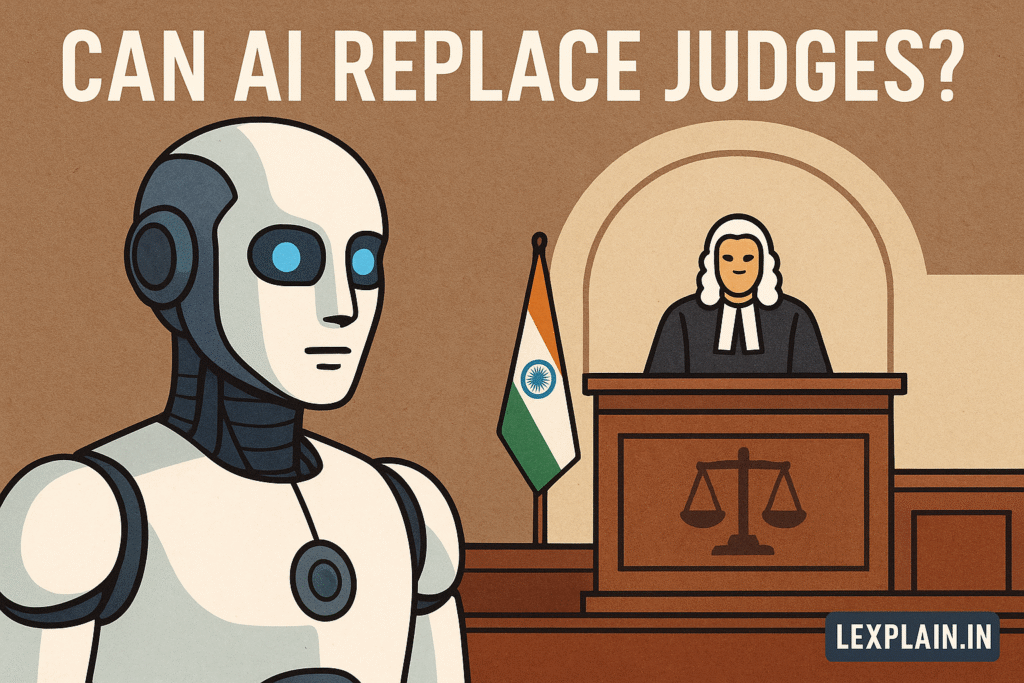Introduction: The AI Revolution and Indian Judiciary (AI in Indian Judiciary)
“Nearly 70% of young professionals in India believe AI will take over many human jobs in the next two decades. But when it comes to justice—deciding right and wrong, liberty and punishment—can a machine ever sit on the judge’s bench?”
Artificial Intelligence (AI) has entered nearly every field—from healthcare to education, from transport to entertainment. In India’s legal system, with over 5 crore pending cases, people are beginning to ask: can AI replace judges in India?
This post dives deep into the future of AI in the judiciary, the challenges of replacing human judges, and the possible ways AI can transform justice delivery.
- Introduction: The AI Revolution and Indian Judiciary (AI in Indian Judiciary)
- AI in Indian Judiciary: Present Initiatives
- Why Do People Think AI Could Replace Judges?
- Challenges of AI Judges in India
- Emotional Side of Justice: Why Humans Matter
- Global Examples of AI in Judiciary
- Future of AI in Indian Courts: Assistant, Not Judge
- Philosophical Debate: Justice vs Efficiency
- Voices from Indian Judiciary
- SEO-Focused Section: Can AI Replace Judges in India?
- Final Verdict: The Role of AI in Justice System
- Conclusion: Justice Needs a Human Heart
AI in Indian Judiciary: Present Initiatives
Before we imagine robot judges, let’s look at where AI already exists in Indian courts:
- SUVAS (Supreme Court Vidhik Anuvaad Software): AI-powered judgment translation into Indian languages.
- SUPACE (Supreme Court Portal for Assistance in Courts Efficiency): Provides judges with quick research and document summaries.
- E-Courts Project: Digital case filing, online cause lists, and automated scheduling.
👉 These tools show AI’s role as a judicial assistant, not as a replacement for judges.
Why Do People Think AI Could Replace Judges?
AI replacing judges might sound like science fiction, but there are real reasons people imagine it:
- Case Backlog: Courts struggle with decades-long delays. AI seems like a solution for clearing pending matters.
- Routine Cases: Cheque bounce, bail hearings, or traffic challans feel suitable for automation.
- Cost and Efficiency: AI promises low-cost, faster, and consistent outcomes.
But does speed equal justice? Let’s see the barriers.
Challenges of AI Judges in India
1. Human Discretion vs Machine Logic
Judging is not math. It requires balancing rights, morality, and social context. AI cannot weigh emotions, trauma, or human dignity.
2. Constitutional Barriers
India’s Constitution ensures judicial independence. Replacing judges with AI would conflict with separation of powers and undermine democracy.
3. Bias in Data and Algorithms
AI learns from past judgments. If those carry caste, gender, or class bias, AI will replicate them. Instead of reforming, it could deepen injustices.
4. Accountability Gaps
If AI wrongly convicts someone, who takes responsibility—the coder, the government, or the court? Justice requires answerability, which machines lack.
5. Emotional Intelligence
A judgment isn’t just words on paper. Victims and litigants want to feel heard and respected. AI cannot provide empathy or compassion.
Emotional Side of Justice: Why Humans Matter
Law is not only about statutes; it is about humanity.
- A widow wants dignity in her pension case.
- A young offender may need counseling, not jail.
- A victim of assault seeks compassion, not just procedure.
AI may process data, but it cannot say: “I understand your pain.” This human touch makes judges irreplaceable.
Global Examples of AI in Judiciary
The world has already tested AI in courts:
- Estonia: Used AI judges for small-value contract disputes (< €7,000).
- China: Runs AI-assisted courts with virtual avatars for routine cases.
- USA & UK: AI helps assess bail/parole risks but faces criticism for racial bias.
👉 Lesson: AI can support courts but cannot deliver justice alone.
Future of AI in Indian Courts: Assistant, Not Judge
Instead of replacing judges, AI can empower them. Possible roles include:
- Drafting bail and adjournment orders
- Translating judgments into local languages
- Scanning evidence and legal precedents
- Tracking case progress and predicting timelines
- Filtering frivolous litigation
This allows judges to focus on complex, sensitive decisions that require human wisdom.
Philosophical Debate: Justice vs Efficiency
The heart of the debate is simple:
- Efficiency: Millions wait for justice. AI could deliver faster, uniform results.
- Fairness: Rushed justice risks ignoring nuance. A wrong decision harms more than a delayed one.
The balance lies in AI-powered efficiency + human fairness.
Voices from Indian Judiciary
Prominent Indian judges have spoken about AI:
- Justice D.Y. Chandrachud (CJI): AI can reduce burdens but not replace judges.
- Justice Bobde (former CJI): AI should support efficiency, not outcomes.
- Senior Advocates: Warn that “automated justice” risks “automated injustice.”
Consensus is clear: AI is a partner, not a replacement.
SEO-Focused Section: Can AI Replace Judges in India?
- Short Answer: No, AI cannot replace judges in India.
- Reason: Justice involves empathy, morality, and constitutional values that machines cannot replicate.
- Reality: AI will remain an assistant in legal research, translation, and case management.
This ensures AI in Indian judiciary becomes a tool for better access, not a threat to human judges.
Final Verdict: The Role of AI in Justice System
The future of justice in India lies in collaboration:
- AI will help with research, translations, and routine orders.
- Judges will retain their role as interpreters of law, protectors of rights, and guardians of fairness.
So the answer isn’t about robot judges. The real future is human judges with AI-powered efficiency.
Conclusion: Justice Needs a Human Heart
Courts are not factories. Justice is not just about output; it is a sacred trust. Machines can assist, but they cannot feel.
The question is not “Will AI replace judges?” but “How can AI help judges serve justice better?”
For India’s young lawyers, law students, and citizens, the revolution is clear: AI will transform courts, but judges will always remain human.

